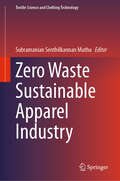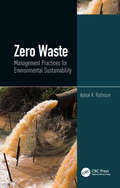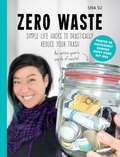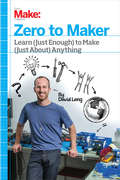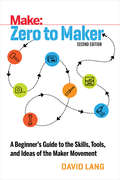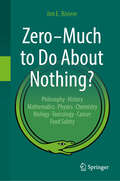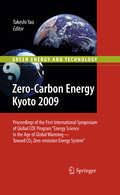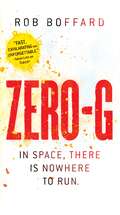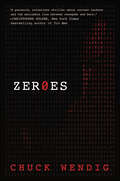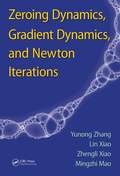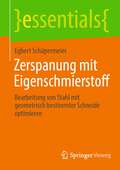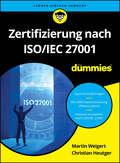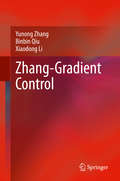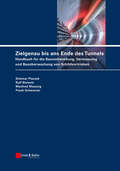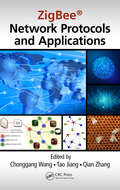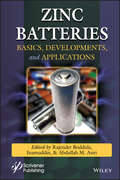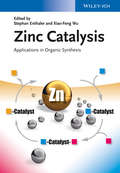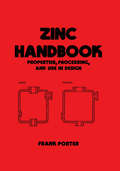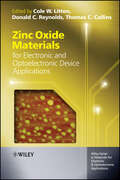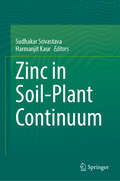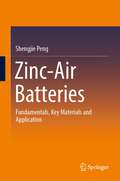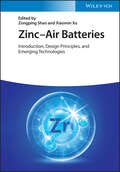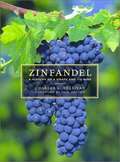- Table View
- List View
Zero Waste Sustainable Apparel Industry (Textile Science and Clothing Technology)
by Subramanian Senthilkannan MuthuThis book offers a variety of cases offering insights into waste assessment and moving towards zero waste in the apparel industry. In an industry as large and widespread as apparel, efforts toward sustainability and waste reduction are critical. The chapters here cover a variety of topics related to apparel sustainability, including management approaches, circular economy methods, and case studies that academics, students, and professionals in this industry can use to continue to strive toward a sustainable future.
Zero Waste: Management Practices for Environmental Sustainability
by Ashok K. RathoureZero Waste: Management Practices for Environmental Sustainability presents approaches for resource management centered on reducing waste and reusing and recycling materials. It aims to save energy by reducing energy consumption associated with extracting, processing, and transporting raw materials and waste, and also to reduce and eventually eliminate the need for landfills and incinerators. This book presents the various principles, methods, and tools that can be used to address different issues in the areas of industrial waste reduction and sustainability. It examines how to eliminate waste at the source and at all points of a supply chain, and how to shift from the current one-way linear resource model to a sustainable "closed-loop" system. Proposes strategies for businesses to reduce and reuse waste with a goal of reaching a zero waste status. Focuses on how mitigating waste and promoting recycling can save vast amounts of energy. Explains how the zero waste approach would be a key measure to ensure environmental sustainability and help to offset global climate change.
Zero Waste: Simple Life Hacks to Drastically Reduce Your Trash
by Shia SuEasy and Effective Strategies to Jumpstart a Sustainable, Waste-Free Lifestyle We have a worldwide trash epidemic. The average American disposes of 4.4 pounds of garbage per day, and our landfills hold 254 million tons of waste. What if there were a simple—and fun—way for you to make a difference? What if you could take charge of your own waste, reduce your carbon footprint, and make an individual impact on an already fragile environment? A zero waste lifestyle is the answer—and Shia Su is living it. Every single piece of unrecyclable garbage Shia has produced in one year fits into a mason jar—and if it seems overwhelming, it isn’t! In Zero Waste, Shia demystifies and simplifies the zero waste lifestyle for the beginner, sharing practical advice, quick solutions, and tips and tricks that will make trash-free living fun and meaningful. Learn how to: Build your own zero waste kitPrepare real food—the lazy wayMake your own DIY household cleaners and toiletriesBe zero waste even in the bathroom!And more! Be part of the solution! Implement these small changes at your own pace, and restructure your life to one of sustainable living for your community, your health, and the earth that sustains you.
Zero to Maker
by David LangAre you possessed by the urge to invent, design, and make something that others enjoy, but don't know how to plug into the Maker movement? In this book, you'll follow author David Lang's headfirst dive into the Maker world and how he grew to be a successful entrepreneur. You'll discover how to navigate this new community, and find the best resources for learning the tools and skills you need to be a dynamic maker in your own right. Lang reveals how he became a pro maker after losing his job, and how the experience helped him start OpenROV--a DIY community and product line focused on open source undersea exploration. It all happened once he became an active member of the Maker culture. Ready to take the plunge into the next Industrial Revolution? This guide provides a clear and inspiring roadmap. Take an eye-opening journey from unskilled observer to engaged maker-entrepreneur Enter the Maker community to connect with experts and pick up new skills Use a template for building a maker-based entrepreneurial lifestyle Learn from the organizer of the first-ever Maker Startup Weekend Be prepared for exciting careers of the future
Zero to Maker: A Beginner's Guide to the Skills, Tools, and Ideas of the Maker Movement
by David LangZero to Maker is part memoir and part how-to guidebook for anyone who is having thoughts like these:I feel like all I can do is write emails. I wish I had more hands-on skills even though I don't know what I would build...I have this one idea I've always wanted to make, but I don't know how to build it...I keep hearing about the "maker movement" but I'm not sure what that means or how I can join in...The book follows author David Lang's headfirst dive into the maker world and shows how he grew from an unskilled beginner to be a successful entrepreneur. You'll discover how to navigate this new community of makers, and find the best resources for learning the tools and skills you need to be a dynamic maker in your own right.The way we make things has changed. A new generation of tinkerers have emerged through online communities and powerful digital fabrication tools, and their creations are changing the world. This book follows the author's personal journey of transformation into a maker-entrepreneur. It is everyone's guide to combining inspiration and resources to effectively navigate this exciting new world.Lang reveals how he became a maker pro after losing his job and how the experience helped him start OpenROV, a DIY community and product line focused on underwater robotics. It all happened once he became an active member of the maker movement. Ready to take the plunge into the next Industrial Revolution? This guide provides a clear and inspiring roadmap.Take an eye-opening journey from unskilled observer to engaged makerLearn how to join this community, get access to tools and experts, and pick up new skillsUse a template for building a maker-based entrepreneurial lifestyle and prepare yourself for the careers of the futureThis book is for everyone who dreams of becoming a successful maker-entrepreneur. It not only satisfies the aspirational aspect but shows newcomers to the maker movement exactly how to join in.First published in 2013, this new edition features full-color photos and shares David's latest insights and experiences as he continues to grow as a maker entrepreneur and citizen scientist.
Zero – Much to Do About Nothing?
by Jim E. RiviereZero – Much to Do About Nothing? is a thought-provoking work that delves into the complexities of defining “zero” in various fields, from mathematics and physics to pharmacology and food safety. Drawing on his extensive experience in teaching, research and managing a USDA-supported chemical food safety program, Jim E. Riviere provides readers with practical examples and case studies that highlight the challenges of defining “zero” in different contexts across a wide range of fields. In his four decades of university teaching, doing research in pharmacology, toxicology, biomathematics and nanoscience, Dr. Riviere has repeatedly encountered the concept of “zero” and the broad parameters utilized to achieve a proper definition. "Zero” enters when discussions concern defining "nothing", "negligible", "very small", "below level of detection", "absence of effect" or "safe". This renders the term “zero” incredibly confusing to scientists, practitioners and regulators. This book explores the origin of the concept of “zero” in mathematics, physics, chemistry and statistics and how these concepts migrated to fields such as pharmacology, toxicology, cancer research and food safety, as well as to the legal profession in the form of regulatory science and policy. Specific chapters deal with the application of “zero” to these distinct fields. The main focus throughout the book is to illustrate how important context is to the definition of “zero”. This has assumed greater relevance today with the advent of nanoscience where “small” implies different physical and chemical behavior and the use of artificial Intelligence to analyze vast troves of data from the web. The goal of the book is to provide much-needed clarity about "zero" and break down the many issues preventing it. Riviere expertly explains how the concept of “zero” is essential to a wide range of issues, from defining negligible amounts of a substance to determining the safety of a product or process. He shows how the term “zero” can have different meanings in different fields and how this can lead to confusion and misunderstandings among scientists, practitioners and regulators. Whether you're working in Food Safety, Chemistry, Pharmacology, Mathematics, Physics or beyond, Zero – Much to Do About Nothing? is a relatable book that will deepen your understanding of the concept of “zero” and its diverse applications.
Zero! The Number That Almost Wasn't
by Sarah AlbeeHow did math work before zero existed? A STEM nonfiction book that unpacks a fascinating history of a number we can&’t imagine our current world without.From place value to being created and destroyed before being created again, zero has had quite a journey. Respected children&’s author and consummate researcher Sarah Albee lays out the history of zero alongside the complications that initially hampered its development, including Western imperialism.A riveting nonfiction kids book with a playful feel, Zero! unravels a complicated history in tremendous detail.
Zero-Carbon Energy Kyoto 2012
by Takeshi YaoThe Global COE is setting out a zero-emission technology roadmap and is promoting socioeconomic studies of energy, studies of new technologies for renewable energies, and research for advanced nuclear energy. It has also established the Global COE Unit for Energy Science Education to support young researchers as they apply their skills and knowledge and a broad international perspective to respond to issues of energy and the environment in our societies. This book follows on the earlier volumes Zero-Carbon Energy Kyoto 2009, 2010, and 2011.
Zero-G (Outer Earth #2)
by Rob BoffardZERO-G is the nonstop sequel to Rob Boffard's Tracer, a brutal, gripping thrill-ride, where the hero moves like lightning and the consequences for failure are deadly.The clock is ticking down again for Riley Hale. She may be the newest member of Outer Earth's law enforcement team, but she feels less in control than ever. A twisted doctor bent on revenge is blackmailing her with a deadly threat. If Riley's to survive, she must follow his orders, and break a dangerous prisoner out of jail. To save her own skin, Riley must go against all her beliefs, and break every law that she's just sworn to protect. Riley's mission will get even tougher when all sectors are thrown into lock-down. A lethal virus has begun to spread through Outer Earth, and it seems little can stop it. If Riley doesn't live long enough to help to find a cure, then the last members of the human race will perish along with her. The future of humanity hangs in the balance. And time is running out.
Zero-Sustainment Aircraft for the U.S. Air Force
by National Research CouncilOverall Air Force weapon system sustainment (WSS) costs are growing at more than 4 percent per year, while budgets have remained essentially flat. The cost growth is due partly to aging of the aircraft fleet, and partly to the cost of supporting higher-performance aircraft and new capabilities provided by more complex and sophisticated systems, such as the latest intelligence, surveillance, and reconnaissance (ISR) platforms. Furthermore, the expectation for the foreseeable future is that sustainment budgets are likely to decrease, so that the gap between budgets and sustainment needs will likely continue to grow wider. Most observers accept that the Air Force will have to adopt new approaches to WSS if it is going to address this problem and remain capable of carrying out its missions. In this context, the original intent of this 3-day workshop was to focus on ways that science and technology (S&T) could help the Air Force reduce sustainment costs. However, as the workshop evolved, the discussions focused more and more on Air Force leadership, management authority, and culture as the more critical factors that need to change in order to solve sustainment problems. Many participants felt that while S&T investments could certainly help--particularly if applied in the early stages ("to the left") of the product life cycle--adopting a transformational management approach that defines the user-driven goals of the enterprise, empowers people to achieve them, and holds them accountable, down to the shop level. Several workshop participants urged Air Force leaders to start the process now, even though it will take years to percolate down through the entire organization. These sustainment concerns are not new and have been studied extensively, including recent reports from the National Research Council's Air Force Studies Board and the Air Force Scientific Advisory Board.
Zeroes
by Chuck Wendig“[A] high-octane blend of nervy characters, dark humor and bristling dialogue... smart, timely, electrifying.” — NPRAn exhilarating thrill-ride through the underbelly of cyber espionage in the vein of David Ignatius’s The Director and the television series Leverage, CSI: Cyber, and Person of Interest, which follows five iconoclastic hackers who are coerced into serving the U.S. government.An Anonymous-style rabble rouser, an Arab spring hactivist, a black-hat hacker, an old-school cipherpunk, and an online troll are each offered a choice: go to prison or help protect the United States, putting their brains and skills to work for the government for one year.But being a white-hat doesn’t always mean you work for the good guys. The would-be cyberspies discover that behind the scenes lurks a sinister NSA program, an artificial intelligence code-named Typhon, that has origins and an evolution both dangerous and disturbing. And if it’s not brought down, will soon be uncontrollable.Can the hackers escape their federal watchers and confront Typhon and its mysterious creator? And what does the government really want them to do? If they decide to turn the tables, will their own secrets be exposed—and their lives erased like lines of bad code?Combining the scientific-based, propulsive narrative style of Michael Crichton with the eerie atmosphere and conspiracy themes of The X-Files and the imaginative, speculative edge of Neal Stephenson and William Gibson, Zer0es explores our deep-seated fears about government surveillance and hacking in an inventive fast-paced novel sure to earn Chuck Wendig the widespread acclaim he deserves.
Zeroing Dynamics, Gradient Dynamics, and Newton Iterations
by Yunong Zhang Lin Xiao Zhengli Xiao Mingzhi MaoNeural networks and neural dynamics are powerful approaches for the online solution of mathematical problems arising in many areas of science, engineering, and business. Compared with conventional gradient neural networks that only deal with static problems of constant coefficient matrices and vectors, the authors’ new method called zeroing dynamics solves time-varying problems. Zeroing Dynamics, Gradient Dynamics, and Newton Iterations is the first book that shows how to accurately and efficiently solve time-varying problems in real-time or online using continuous- or discrete-time zeroing dynamics. The book brings together research in the developing fields of neural networks, neural dynamics, computer mathematics, numerical algorithms, time-varying computation and optimization, simulation and modeling, analog and digital hardware, and fractals.The authors provide a comprehensive treatment of the theory of both static and dynamic neural networks. Readers will discover how novel theoretical results have been successfully applied to many practical problems. The authors develop, analyze, model, simulate, and compare zeroing dynamics models for the online solution of numerous time-varying problems, such as root finding, nonlinear equation solving, matrix inversion, matrix square root finding, quadratic optimization, and inequality solving.
Zerspanung mit Eigenschmierstoff: Bearbeitung von Stahl mit geometrisch bestimmter Schneide optimieren (essentials)
by Egbert SchäpermeierDieses essentials behandelt einen neuen Ansatz zur effizienteren Zerspanung von Stählen: Bei der Spanbildung handelt es sich um einen Vorgang mit unvollkommener Ähnlichkeit. Die Ähnlichkeitsmechanik geht davon aus, dass sich nur vollkommene Vorgänge geschlossen analytisch darstellen lassen. Daher wird der wirtschaftlich interessante Bereich der Zerspanung abgegrenzt, welcher vollkommene Ähnlichkeit besitzt und für diesen Bereich erstmals die analytischen Grundlagen für Lehre, Studium, Forschung, Entwicklung und Fertigung zusammengestellt. Ergebnis ist eine Optimierung der Maschineneinstelldaten für eine wirtschaftlichere und ressourcenschonendere Produktion.
Zertifizierung nach ISO/IEC 27001 für Dummies (Für Dummies)
by Martin Weigert Christian HeutgerInformationssicherheit mit System – Zertifizierung mit Durchblick In Ihrem Unternehmen sollen ein Informationssicherheits-Managementsystem (ISMS) und Prozesse nach ISO/IEC 27001 implementiert werden? Sie suchen nach gut aufbereiteten Informationen? Dieses Buch beschreibt konkrete Maßnahmen für die pragmatische Umsetzung, die die Informationssicherheit in Ihrer Organisation gewährleisten. So werden Sie die komplexen Anforderungen besser verstehen und das Vorgehen sinnvoll planen können. Für typische Herausforderungen finden Sie praxisnahe Tipps und Tricks. Als zusätzlichen Mehrwert enthält das Buch die komplette Norm im Wortlaut. Sie erfahren Wie Sie die ISO/IEC 27001 strukturiert implementieren Wie Sie das ISMS kontinuierlich pflegen und verbessern Welchen Fragen Sie sich im Zertifizierungsaudit stellen müssen Was für die Aufrechterhaltung Ihrer Zertifizierung wichtig ist
Zhang-Gradient Control
by Yunong Zhang Xiaodong Li Binbin QiuThis book introduces readers to using the simple but effective Zhang-gradient (ZG) method to solve tracking-control problems concerning various nonlinear systems, while also highlighting the applications of the ZG method to tracking control for practical systems, e.g. an inverted-pendulum-on-a-cart (IPC) system and a two-wheeled mobile robot (showing its potential applications). In addition to detailed theoretical analyses of ZG controllers, the book presents a wealth of computer simulations to demonstrate the feasibility and efficacy of the controllers discussed (as well as the method itself). More importantly, the superiority of ZG controllers in overcoming the division-by-zero (DBZ) problem is also illustrated. Given its scope and format, the book is well suited for undergraduate and graduate students, as well as academic and industrial researchers in the fields of neural dynamics/neural networks, nonlinear control, computer mathematics, time-varying problem solving, modeling and simulation, analog hardware, and robotics.
Zielgenau bis ans Ende des Tunnels: Handbuch fur die Bauvorbereitung, Vermessung und Bauuberwachung von Schildvortrieben
by Dietmar Placzek Rolf Bielecki Manfred Messing Frank SchwarzerDamit der fertige Tunnel am Ende seine Funktion erfüllen kann, muss er exakt so liegen, wie er geplant wurde. Einfluss auf die Vortriebsgenauigkeit haben Trassen- und Gradientenplanung, Baugrund- und Grundwasserverhältnisse, das gewählte Vortriebsverfahren, Einwirkungen und Widerstände auf die Vortriebsmaschine sowie die begleitende Bauüberwachung und Kontrolle. Das Handbuch ist Grundlage für die Bauvorbereitung, die Vermessung und Bauüberwachung von Schildvortrieben und gilt gleichermaßen für Rohr- und Tübbingvortriebe, die mit gesteuerten Schildmaschinen durchgeführt werden. Bauherren, Planer, Prüfer und Ausführenden werden dieses Handbuch als technischen Leitfaden für einen sicheren und zielgenauen Vortrieb nutzen. Das Buch ist darüber hinaus auch als Lehrbuch im Rahmen der Aus- und Weiterbildung geeignet.
ZigBee Network Protocols and Applications
by Tao Jiang Qian Zhang Chonggang WangCompared with other wireless communication technologies, such as Bluetooth, WiFi, and UWB, ZigBee is a far more reliable, affordable, and energy-efficient option. It is also the only global wireless communication standard for easily deployed, low-power consumption products.ZigBee Network Protocols and Applications provides detailed descriptions of
Zinc Batteries: Basics, Developments, and Applications
by Inamuddin Abdullah M. Asiri Rajender BoddulaBattery technology is constantly changing, and the concepts and applications of these changes are rapidly becoming increasingly more important as more and more industries and individuals continue to make “greener” choices in their energy sources. As global dependence on fossil fuels slowly wanes, there is a heavier and heavier importance placed on cleaner power sources and methods for storing and transporting that power. Battery technology is a huge part of this global energy revolution. Zinc batteries are an advantageous choice over lithium-based batteries, which have dominated the market for years in multiple areas, most specifically in electric vehicles and other battery-powered devices. Zinc is the fourth most abundant metal in the world, which is influential in its lower cost, making it a very attractive material for use in batteries. Zinc-based batteries have been around since the 1930s, but only now are they taking center stage in the energy, automotive, and other industries. Zinc Batteries: Basics, Developments, and Applicationsis intended as a discussion of the different zinc batteries for energy storage applications. It also provides an in-depth description of various energy storage materials for Zinc (Zn) batteries. This book is an invaluable reference guide for electrochemists, chemical engineers, students, faculty, and R&D professionals in energy storage science, material science, and renewable energy.
Zinc Catalysis
by Xiao-Feng Wu Stephan EnthalerFilling the gap in the market for comprehensive coverage of this hot topic, this timely book covers a wide range of organic transformations, e. g. reductions of unsaturated compounds, oxidation reactions, Friedel-Crafts reactions, hydroamination reactions, depolymerizations, transformations of carbon dioxide, oxidative coupling reactions, as well as C-C, C-N, and C-O bond formation reactions. A chapter on the application of zinc catalysts in total synthesis is also included. With its aim of stimulating further research and discussion in the field, this is a valuable reference for professionals in academia and industry wishing to learn about the latest developments.
Zinc Handbook: Properties, Processing, and Use In Design (Mechanical Engineering #Vol. 73)
by Frank C. PorterSummarizes information on all aspects of metallic zinc and gives references to additional source material, including major books and reviews. At the heart of the reference are 16 chapters that cover coatings and electrochemical protection of steel by zinc.
Zinc Oxide Materials for Electronic and Optoelectronic Device Applications
by Peter Capper Safa Kasap Arthur Willoughby Cole W. Litton Thomas C. Collins Donald C. ReynoldsZinc Oxide (ZnO) powder has been widely used as a white paint pigment and industrial processing chemical for nearly 150 years. However, following a rediscovery of ZnO and its potential applications in the 1950s, science and industry alike began to realize that ZnO had many interesting novel properties that were worthy of further investigation.ZnO is a leading candidate for the next generation of electronics, and its biocompatibility makes it viable for medical devices. This book covers recent advances including crystal growth, processing and doping and also discusses the problems and issues that seem to be impeding the commercialization of devices.Topics include:Energy band structure and spintronics Fundamental optical and electronic properties Electronic contacts of ZnO Growth of ZnO crystals and substrates Ultraviolet photodetectors ZnO quantum wells Zinc Oxide Materials for Electronic and Optoelectronic Device Applications is ideal for university, government, and industrial research and development laboratories, particularly those engaged in ZnO and related materials research.
Zinc in Soil-Plant Continuum
by Sudhakar Srivastava Harmanjit KaurThis contributed volume covers the role of zinc in soil and plant systems, providing a comprehensive understanding of factors influencing its total and bioavailable levels. The book presents the mechanisms of zinc uptake, translocation, and homeostasis in plants under both Zn-deficient and Zn-excess conditions. It also addresses a variety of agronomic, biotechnological, and microbial approaches for managing zinc nutrition in crops. Plants have evolved intricate systems of transporters and regulatory mechanisms to obtain trace amounts of zinc, which is crucial for their growth and yield. Zinc homeostasis is essential for optimal crop performance, yet its availability in the environment varies significantly. While some regions of the world experience severe zinc deficiency, others face zinc toxicity. This poses a dual challenge: zinc deficiency in crops negatively impacts the nutrition of millions of people dependent on plant-based diets, while zinc toxicity can lead to excessive zinc accumulation in crops, posing health risks to humans. The book highlights significant advancements in improving zinc nutrition in crops, presenting cutting-edge research and strategies to address these challenges. It offers insights into the broader implications of zinc in agriculture and human nutrition, bridging the gap between plant health and public health. This book is an invaluable resource for undergraduate and postgraduate students, researchers, and academicians. It is particularly relevant for those studying or working in the fields of crop nutrition, essential elements in plants, zinc deficiency and toxicity in soils, the role of zinc in human health, and sustainable agricultural practices.
Zinc-Air Batteries: Fundamentals, Key Materials and Application
by Shengjie PengThis book aims to discuss the cutting-edge materials and technologies for zinc-air batteries. From the perspective of basic research and engineering application, the principle innovation, research progress, and technical breakthrough of key materials such as positive and negative electrodes, electrolytes, and separators of zinc-air batteries are discussed systematically, which can be used to guide and promote the development of zinc-air battery technology. We do believe that our experiences and in-depth discussions would make this book useful for researchers at all levels in the energy area and provide them with a quick way of understanding the development of zinc-air batteries.
Zinc-Air Batteries: Introduction, Design Principles, and Emerging Technologies
by Zongping Shao Xiaomin XuZinc–Air Batteries Authoritative and comprehensive resource covering foundational knowledge of zinc–air batteries as well as their practical applications Zinc–Air Batteries provides a comprehensive understanding of the history and development of Zn–air batteries, with a systematic overview of components, design, and device innovation, along with recent advances in the field, especially with regards to the cathode catalyst design made by cutting-edge materials, engineering processes, and technologies. In particular, design principles regarding the key components of Zn–air batteries, ranging from air cathode, to zinc anode, and to electrolyte, are emphasized. Furthermore, industrial developments of Zn–air batteries are discussed and emerging new designs of Zn–air batteries are also introduced. The authors argue that designing advanced Zn–air battery technologies is important to the realization of efficient energy storage and conversion—and, going further, eventually holds the key to a sustainable energy future and a carbon-neutral goal. Edited and contributed to by leading professionals and researchers in the field, Zinc–Air Batteries also contains information regarding: Design of oxygen reduction catalysts in primary zinc–air batteries, including precious metals, single-atoms, carbons, and transition metal oxides Design of bifunctional oxygen catalysts in rechargeable zinc–air batteries, covering specific oxygen redox reactions and catalyst candidates Design of three-dimensional air cathode in zinc–air batteries, covering loading of carbon-based and transition metal catalysts, plus design of the three-phase interface Design of electrolyte for zinc–air batteries, including liquid electrolytes (e.g., alkaline) and gel polymer electrolytes (e.g., PVA hydrogel) For students, researchers, and instructors working in battery technologies, materials science, and electrochemistry, and for industry and government representatives for decision making associated with energy and transportation, Zinc–Air Batteries summarizes the research results on Zn–air batteries and thereby helps researchers and developers to implement the technology in practice.
Zinfandel: A History of a Grape and Its Wine
by Charles L. SullivanThe Zinfandel grape--currently producing big, rich, luscious styles of red wine--has a large, loyal, even fanatical following in California and around the world. The grape, grown predominantly in California, has acquired an almost mythic status--in part because of the caliber of its wines and its remarkable versatility, and in part because of the mystery surrounding its origins. Charles Sullivan, a leading expert on the history of California wine, has at last written the definitive history of Zinfandel. Here he brings together his deep knowledge of wine with the results of his extensive research on the grape in the United States and Europe in a book that will entertain and enlighten wine aficionados and casual enthusiasts. In this lively book, Sullivan dispels the false legend that has obscured Zinfandel's history for almost a century, reveals the latest scientific findings about the grape's European roots, shares his thoughts on the quality of the wines now being produced, and looks to the future of this remarkable grape. Sullivan reconstructs Zinfandel's journey through history--taking us from Austria to the East Coast of the U. S. in the 1820s, to Gold Rush California, and through the early days of the state's wine industry. He considers the ups and downs of the grape's popularity, including its most recent and, according to Sullivan, most brilliant "up. " He also unravels the two great mysteries surrounding Zinfandel: the myth of Agoston Haraszthy's role in importing Zinfandel, and the heated controversy over the relationship between California Zinfandel and Italian Primitivo. Sullivan ends with his assessments of the 2001 and 2002 vintages, firmly setting the history of Zinfandel into the chronicles of grape history.
